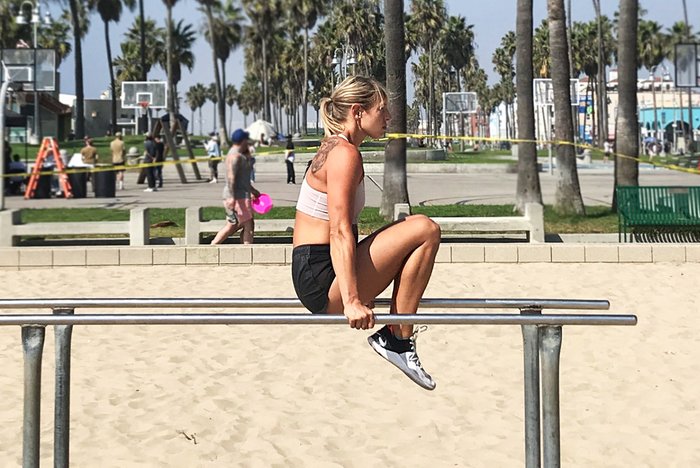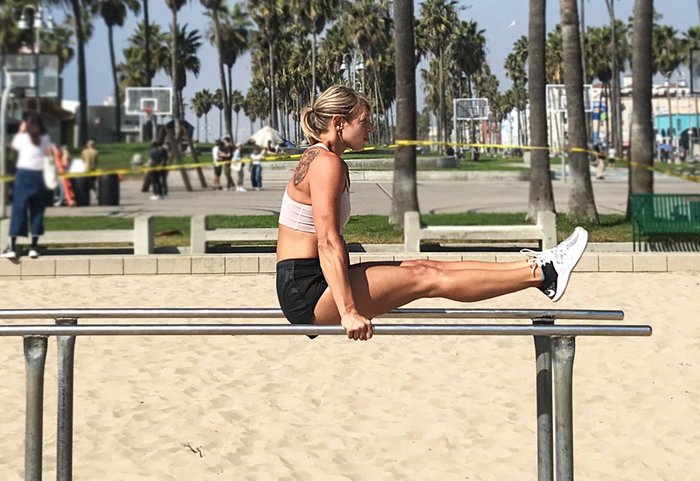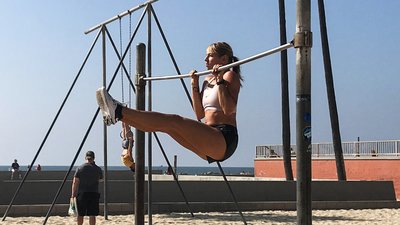L-sits are one of those exercises that look a lot easier than they are. I mean, holding your legs out in front of you isn't really that hard, is it?
Yes, it is.
The first time I tried this exercise, I thought that maybe my legs were too long and it was just physically impossible for me to do it. Looking back now, it's pretty obvious I simply lacked the abs or the hip flexor strength to do one, but I just didn't know it at the time.
That's right: abs and hip flexors. L-sits aren't one of those movements where you want to "turn off" your hip flexors in order to focus on your abs. These two powerful muscle groups need to play together—with plenty of other muscles—to pull off a solid L-sit. You need core strength, hip flexor strength, shoulder and arm strength, and hamstring flexibility. But once you can cruise through a couple of 30-second L-sits, you'll find that all that strength and flexibility carries over into other lifts and activities, as well. Handstands, lifting, yoga—they're all better with a stronger core, shoulders, and overall muscular coordination.
But L-sits almost never happen without some work. To build up to the full move, you need the proper series of progressions—or more accurately, regressions—to build up the necessary strength.
Keep in mind this isometric hold can be performed on many different pieces of equipment including parallel bars, parallettes, dumbbells, yoga blocks, a pull-up bar, or even with your hands flat on the ground. When you're first starting out, I recommend using some type of parallel bars to start building the strength necessary to hold your legs parallel to the ground.
To build up to a full L-sit, train these techniques at least three times a week. Since this exercise requires a tremendous amount of core strength, you might also need more core exercises, such as the V-sit or leg raises, added to your strength training program. Regardless of whether you add more abs to your workout or not, if you follow this simple series of exercises, you'll be rocking this calisthenics staple in no time.
Tuck L-Sit
The tuck L-sit is a lot easier for beginners because your legs are bent, so your core is holding up a shorter lever. As any physics buff will tell you, the shorter the lever, the less force required to move it, so you don't need as much core strength to hold tucked legs up.
To perform this regression, grab onto parallel bars with both hands and squeeze your core to push up through your shoulders and lift your body up into a support hold. Once in position, tuck your knees toward your chest and hold for time. Work up to holding this position for 3 rounds of 30 seconds.

With this and every other L-sit progression, work to keep your torso upright with your chest up and your shoulder blades retracted.
Single-Leg L-Sit
A natural progression from the tuck version, this move lets you do half the work of a full L-sit by only putting one leg out at a time. This will help strengthen your hip flexors on each side and build your core strength up to be able to hold both legs at the same time.
As with the tuck, start by grabbing onto the parallel bars with both hands and pushing up into position with your core engaged and your knees tucked toward your chest. Extend one leg out in front of you and hold for time before bringing it back in and extending the other leg. Work up to a solid 30-second hold on each leg. Make sure to work both sides to build strength evenly.
Full L-Sit
In addition to strength, you'll need hamstring flexibility to hold your legs out straight for this move. If your hamstrings are too tight, you might end up with bent knees or a rounded back, which can put extra strain on your joints. For tips on how to increase your flexibility, be sure to check out my article "5 Stretches Every Lifter Needs to Do."

Once you've mastered the two regressions above, you're ready to attempt a full L-sit. Get into your support hold, squeeze your core, and extend both legs in front of you, keeping your legs as straight as possible. Try to focus on keeping your chest up and toes pointed to keep every muscle in your legs active. Hold for time, working up to 30-second holds.
Advanced L-Sit Variations
Once you can hold the full L-sit for 10 seconds or more, you can start to add some variations to your L-sits to keep building strength and keep progressing. Here are some of my favorite L-sit variations to add to your training:
L-sit Tuck
Instead of just a static hold, this exercise tests your total-body strength as you move your legs in and out of the tuck position. Starting from a full L-sit position, tuck your knees toward your chest, hold, then extend your legs back out. Repeat for as many reps as you can with good form.
Parallel Bar Scissors
Any time you add movement to a static hold you create more resistance for your core, which in turn builds more strength and greater total-body control. For the scissors, start in a L-sit position, then scissor your legs back and forth sideways, moving your right leg underneath your left leg, then your left underneath your right.
L-sit Pull-Up
Ready to be humbled? This is a killer total-body combination and a move that requires a lot of strength and control.
From a dead hang, pull your legs up into a full hanging L-sit position. Pull your chest up to the bar, then lower back down, maintaining the L-sit position throughout the pull-up. Your core will let you know almost immediately how tough this is! Use the grip that's the most comfortable for your shoulders and elbows: overhand, underhand, neutral (palms facing inward), or on rings.
Want a complete program to develop bodyweight strength and help you train and move like an athlete? Check out Total Fitness with Andy Speer.

